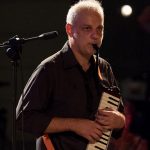Melodica Timbre
Tagged: timbre
- This topic has 8 replies, 3 voices, and was last updated 5 years, 7 months ago by
 Gianluca Barbaro.
Gianluca Barbaro.
-
AuthorPosts
-
September 3, 2018 at 6:22 pm #10238
 Alan BrintonParticipant
Alan BrintonParticipantIt is with great frequency (pun intended) in Melodica World that comparisons are made and preferences expressed in relation to the sound of different melodicas. The terms in which comparisons are made tend to be poorly defined and subjectively applied. Sometimes comparisons are made with other instruments. For example, a melodica is said to have have a harmonica sound or an accordion sound or a woodwind sound. I’ve tried sometimes to make some comparisons with sound samples of different instruments.
One well defined concept used in distinguishing musical instruments by sound is timbre. Each type of musical instrument has its own unique sound, and these unique sounds or types of sound are commonly differentiated in terms of timbre. Timbre is measurable, though I haven’t yet found an app for that. There are timbre preference tests, used by school orchestra leaders to determine which instruments to assign to which students. It is regarded as likely that the student with an instrument that fits her timbre preference will be more motivated and more successful. There’s a whole lot of scholarly literature on timbre preferences, on the extent to which they are determined by gender differences, for example, or by personality types.
Timbre is influenced by the instrument, how it is played, and by combination with the sounds of accompanying instruments.
Instrument choices by composers of music for groups and orchestras are said to be determined or influenced by the timbres of the particular instruments, and by the qualities of sound of their being played together. (Yes, Daren, I’m thinking of you.)
Consider the possible implications of all this for comparisons of melodica sound and for differences in our individual melodica model and brand preferences? If the differences in timbre between different instruments are measurable, then so are the slighter differences between different instruments of a particular type. Shapes, sized, materials of different trumpets (for example) are correlated with differences in timbre, and the same must be true with melodicas.
The relevant concepts are explained nicely in the following video, especially for those of us who are not physicists or sound engineers.
September 3, 2018 at 9:10 pm #10239 Alan BrintonParticipant
Alan BrintonParticipantOkay, so I just ran the Oscilloscope app on my Android tablet while playing Daren’s 13 Melodica Comparison. This is pretty basic stuff for many here, I know. The melodicas are accompanied for all thirteen entries, of course, but the accompaniment is the same. I don’t know much about interpreting oscilloscope readings, but there are obvious differences for the thirteen, and some of them are more alike than others. Same with the handful of melodicas I have here on my desk. The flattest Middle C readings are for my hybrid Yamaha P-37E, which also sounds the most muted (in the sense in which I understand that term). The Suzuki M-37C has more highs and lows. Closer to the Yamaha, though with slightly more pronounced highs and lows, is a first generation (small key) Hohner Piano 27. I regard the Piano 27 as more muted than most melodicas, and these readings are indicative of how muted my P-37E is.
Now for Andre’s Scala Scaletta/Yamaha P-32D comparison: The readings from Andre’s comparison are remarkably close for the two instruments. I’m guessing that a closer comparison of the oscilloscope readings by a more informed reader would shed light on what makes for the differences Daren and I hear (and disagreed about).
I’m now remembering that I have seen reference to such technicalities in a Japanese blog.
September 3, 2018 at 10:32 pm #10242 DarenKeymaster
DarenKeymasterI also find that timbre (and volume/projection) has changed considerably as my technique progresses. The lighter the touch, freer the breathing, and softer the musculature of the whole body, the warmer and more open and resonant the timbre becomes.
September 4, 2018 at 8:26 am #10243 Gianluca BarbaroParticipant
Gianluca BarbaroParticipantMy take on the subject is that there are two other important factors to the timbre of an instrument:
– ADSR envelope curve (Attack-Decay-Sustain-Release)
– ResonanceThe envelope curve mainly depends on the physical attributes and construction of the instrument, but it can be greatly influenced by the player through articulation (how you attack the sound, what you do during the emission, how you close it), and it has a great impact on timbre perception.
Resonance is the sympathetic vibration of other bodies. We have resonance within the instrument (again, construction and materials) but unsurprisingly there is some mouth and head resonance even when playing the melodica (as it happens with any other wind instrument and with voices). In general, resonance affects volume but, being at different frequencies, it can substantially change the harmonic spectrum thus changing the timbre.
Both factors are, to a certain extent, in the “hands” of the player and would account for what Daren wrote:
– a steady and consistent air flow
– resonance (through body relaxation, different mouth shapes, etc.)
– articulation control (different tongue and key attacks, control during the sound life, control over the closing of the sound)These two factors clearly influence the harmonic spectrum thus making the use of an oscilloscope somehow limited and less reliable. Actually, being a large part of the timbre influenced by the player, I find it almost impossible to have an “objective” timbre analysis, unless we restrain the context (i.e. one single note mechanically produced), but I guess that wouldn’t tell us much 🙂
September 4, 2018 at 2:29 pm #10245 Alan BrintonParticipant
Alan BrintonParticipantGreat comments, Gianluca. What if we are making measurements relative to the particular player, so that what we are making measurements that help identify differences and preferences relative to that player? Aside from that qualification, won’t the measurements aid in grouping different bands or models as being similar in sound?
If I say that among five melodicas, the Juliette Pianola is the one that sounds most like the Borel Clavietta, wouldn’t oscilloscope readings help in trying to confirm or disconfirm my claim? If so, would it do so only in relation to the person who is playing during the test?
September 4, 2018 at 9:23 pm #10247 Gianluca BarbaroParticipant
Gianluca BarbaroParticipantAlan, clearly it is a very complex subject. There are many parameters to be taken into account. Here are a few that come to mind:
– microphone quality/specs
– algorithm used for spectrum analysis
– distance from microphone
– room reverberation
and then:
– air flow
– oral cavity resonance
– articulation
– pitch of the noteand finally, certainly the physical characteristics of the instrument but also its state of preservation and, eventually, its tuning.
There may be other parameters, but they all influence timbre in subtle ways that are very difficult to see in graphical representations of the harmonic spectrum. But they are clearly perceived by our ears.
In my experience (I took a few measurements of different recorders a few years ago), with a spectrum analyzer we can see only very evident differences and, truth is, the spectrum can be vastly influenced by the player.
I know that all high-end recorder makers have one or more pro players to test new instruments: that makes sense because professional players know what to expect from an instrument, how it should sound _to_them_ (considering their playing style) and thus they have an internal reference. But they can just decided whether or not an instrument works: the sound of another player would never be the same as theirs. To a certain extent, I think the situation is not that different with melodicas…
It would be even worse, in my opinion, to analyze the spectrum of a recording: youTube, for example, has its own compression algorithms which obviously alter the sound.
That said, I find the spectrum analyzer extremely useful to see how we can alter the timbre by shaping our oral cavity or by altering the air flow.
September 6, 2018 at 2:15 pm #10253 Alan BrintonParticipant
Alan BrintonParticipantThank you, Gianluca, for providing such an informative explanation. I’m sure it will be helpful to others as well. I am just an acoustic player who makes no use of any electronics, seldom even a microphone or sound recorder, except in working with Band-In-A-Box for accompaniment.
September 6, 2018 at 5:50 pm #10256 Gianluca BarbaroParticipant
Gianluca BarbaroParticipantAlan, I am no scientist nor engineer myself, I just studied the matter a little bit and made some experience 🙂
But now you got me curious: I will make some measurements myself with the different melodicas I have, and maybe I will post a video.
glSeptember 13, 2018 at 9:07 am #10287 Gianluca BarbaroParticipant
Gianluca BarbaroParticipantI have made a little comparison video between the Yamaha P37D e the Hammond Pro 44H.
There are actual differences in the higher harmonics: how they map to timbre differences is a little difficult for me to say.
In the last part of the video I play a B on the Yamaha and change the oral cavity shape (and resonance): as you can see, that way we can control the volume of the harmonics (especially the first ones, but notice that the fundamental is constant) thus changing the timbre a little bit. -
AuthorPosts
- You must be logged in to reply to this topic.
